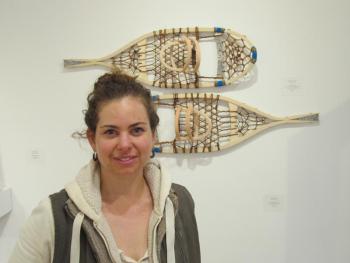From cabinets to coffins: the evolution of a young woodworker
 Rachel Davis stands before her first project, a set of snowshoes using steam bent wood during her nine-month comprehensive program at Center for Furniture Craftsmanship. (Photo by Kay Stephens)
Rachel Davis stands before her first project, a set of snowshoes using steam bent wood during her nine-month comprehensive program at Center for Furniture Craftsmanship. (Photo by Kay Stephens)
 Rachel Davis stands before her first project, a set of snowshoes using steam bent wood during her nine-month comprehensive program at Center for Furniture Craftsmanship. (Photo by Kay Stephens)
Rachel Davis stands before her first project, a set of snowshoes using steam bent wood during her nine-month comprehensive program at Center for Furniture Craftsmanship. (Photo by Kay Stephens)
ROCKPORT—Rachel Davis, 35, is one of the students about to graduate from the Center For Furniture Craftsmanship. Among the many intricate, beautiful student-made pieces currently showing at the center’s gallery, Davis’s maple casepiece is deceivingly simple when viewed straight on. The display cabinet, which is hung on the wall, has a stained glass door and Shaker drawers. The complexities lie in the casepiece. When viewed from the side, there’s a visual surprise: a honeycomb of holes where the drawers and sides of the case should be.
“Throughout the entire course, there has been an emphasis on us finding our own design expression,” she said. “I was partly inspired by the Chinese concept of li, which is how designs in nature form through interaction, such as how the waves move, or the branching of rivers, frost crystals, ferns and shell patterns,” she said. “I was looking at cell structure and wanted this piece to be an interpretation of that. I was also influenced by the ceramic artist, Autumn Cipala so, I went to go visit her in her studio and she had this beautiful tea pot which was simple and plain on the outside but to lift the top off it, it had all of these little artistic holes in it. I wanted to see if I could create a similar form in wood.”
In the woodworking building, Davis has a workspace like all of the other students, including a dovetailed joint wall-mounted case that holds most of her tools. “We all had to make our own cases like this,” she explained. “Then, we get to take them home when we are done with the course.” Throughout the course, she has made: a coffee table, stool, kaleidoscopes, a variety of tools, snowshoes, and is currently working on two chairs with upholstered elements.
Nine months is a long time to spend learning to work with wood and Davis acknowledged it can be an economic challenge for many.
“A lot of people in my class just finshed university right now, and are looking for a way to broaden their skill base,” she said. Davis, who works as a baker on the weekends, piecemeals her income together to make this course work for her.
After making a variety of projects, all with a functional purpose during these nine months, Davis came to the realization that she didn’t want to simply make furniture or beautiful art pieces; she wanted to build something with a deeper meaning to her. Before coming to the Center for Furniture Craftsmanship, she’d social pedagogy at the University of Aberdeen in Scotland while working as a bread baker. All of these experiences, along with her natural aesthetic led her to “build creatively, innovatively and responsibly” in the area of eco-conscious coffins and urns.
“In my social work, I’ve helped a few people at their end of life, and so, I’m especially drawn to this,” she said. “Functional art is stressed throughout the entire program and that’s what will be part of my coffins.”
Far back in the woodworking building, a simple pine box sits on a table with hand-carved flowers. It has hemp handles, no metal parts and is designed to let air flow through the tooled scrollwork. Another design, sitting on top of it resembles a wooden peapod boat, with burlap edging.
“I wanted to design something more organic that would look like the vessel itself was cocooning tor embracing the body,” she said.
The class will be done June 1 and immediately, Davis will start her new business Pear Tree Coffins and Urns. For more information visit: peartreecoffinsandurns.com
Davis’s work as well as many other talented woodworking students from the Center For Furniture Craftsmanship currently are on display at the Center’s Messler Gallery. For more information visit: www.woodschool.org
Photos by Kay Stephens
Kay Stephens can be reached at news@penbaypilot.com
Event Date
Address
United States


























